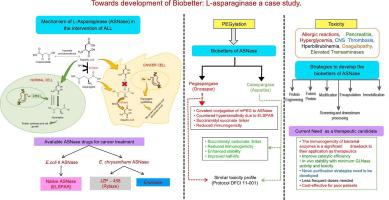Biochimica et Biophysica Acta (BBA) - General Subjects ( IF 3 ) Pub Date : 2023-10-31 , DOI: 10.1016/j.bbagen.2023.130499 Rajan K Tripathy 1 , J Anakha 1 , Abhay H Pande 1

|
Background
L-asparaginase (ASNase) has played a key role in the management of acute lymphoblastic leukaemia (ALL). As an amidohydrolase, it catalyzes the hydrolysis of L-asparagine, a crucial step in the treatment of ALL. Various ASNase variants have evolved from diverse sources since it was first used in paediatric patients in the 1960s. This review describes the available ASNase and approaches being used to develop ASNase as a biobetter candidate.
Scope of review
The review discusses the Glycosylation and PEGylation techniques, which are frequently used to develop biobetter versions of the majority of the therapeutic proteins. Further, it explores current ASNase biobetters in therapeutic use and discusses the protein engineering and chemical modification approaches that were employed to reduce immunogenicity, extend protein half-life, and enhance protease stability of ASNase. Emerging strategies like immobilization and encapsulation are also highlighted as potential pathways for improving ASNase properties.
Major conclusions
The purpose of the development of ASNase biobetter is to achieve a novel therapeutic candidate that could improve catalytic efficiency, in vivo stability with minimum glutaminase (GLNase) activity and toxicity. Modification of ASNase by immobilization and encapsulation or by fusion technologies like Albumin fusion, Fc fusion, ELP fusion, XTEN fusion, etc. can be exploited to develop a novel biobetter candidate suitable for therapeutic approaches.
General significance
This review emphasizes the importance of biobetter development for therapeutic proteins like ASNase. Improved ASNase molecules have the potential to significantly advance the treatment of ALL and have broader implications in the pharmaceutical industry.
中文翻译:

迈向生物更好的发展:L-天冬酰胺酶案例研究
背景
L-天冬酰胺酶 (ASNase) 在急性淋巴细胞白血病 (ALL) 的治疗中发挥着关键作用。作为一种酰胺水解酶,它催化 L-天冬酰胺的水解,这是治疗 ALL 的关键步骤。自 20 世纪 60 年代首次用于儿科患者以来,各种 ASNase 变体已从不同来源演变而来。这篇综述描述了可用的 ASNase 以及用于开发 ASNase 作为生物改良候选药物的方法。
审查范围
该综述讨论了糖基化和聚乙二醇化技术,这些技术经常用于开发大多数治疗性蛋白质的生物更好版本。此外,它还探讨了当前 ASNase 在治疗用途中的生物改良剂,并讨论了用于降低免疫原性、延长蛋白质半衰期和增强 ASNase 蛋白酶稳定性的蛋白质工程和化学修饰方法。固定化和封装等新兴策略也被认为是改善 ASNase 特性的潜在途径。
主要结论
开发 ASNase biobetter 的目的是获得一种新型治疗候选药物,可以提高催化效率、体内稳定性,同时将谷氨酰胺酶 (GLNase) 活性和毒性降至最低。通过固定和封装或通过融合技术(如白蛋白融合、Fc 融合、ELP 融合、XTEN 融合等)对 ASNase 进行修饰,可用于开发适合治疗方法的新型生物更好候选药物。
一般意义
这篇综述强调了 ASNase 等治疗性蛋白质的生物改良开发的重要性。改进的 ASNase 分子有可能显着推进 ALL 的治疗,并在制药行业产生更广泛的影响。



























 京公网安备 11010802027423号
京公网安备 11010802027423号